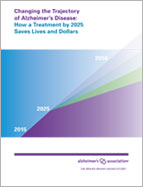At least the Alzheimers Association has some intelligent people that can put together a report like this. We in stroke however have absolutely nothing like this, which seems odd that with three major stroke organizations, ASA, NSA, WSO; not one has anyone intelligent enough to produce such a report. I'm sure we could prove that stroke will affect more people and have a greater financial impact. But we have NO leaders that are even willing to try to tackle all the problems in stroke.
Do you want to be known as the stroke leaders that did nothing but twiddle your thumbs?
NSA President - Mr. Lopez
AHA President - Dr. Arnett
WSO President - Dr. Davis
Changing the Trajectory of Alzheimer's Disease
| Changing the Trajectory of Alzheimer's Disease: How a Treatment by 2025 Saves Lives and Dollars
presents information about the current trajectory and economic impact
of Alzheimer's disease, and describes an alternate trajectory if, in
2025, a treatment became available to delay the onset of Alzheimer's. |
  |
Summary
Changing the Trajectory of Alzheimer's Disease: How a Treatment by 2025 Saves Lives and Dollars calculates that a treatment introduced in 2025 that delays the onset of Alzheimer's by five years would reduce the number of individuals affected by the disease by 5.7 million by mid-century and save all payers, including Medicare, Medicaid and families, more than $220 billion within the first five years.The report reinforces the value of reaching the 2025 goal set by the National Plan to Address Alzheimer's Disease under the National Alzheimer's Project Act (NAPA). If the federal government were to invest $2 billion per year as recommended by the scientific community, then it would recoup its investment within the first three years after a treatment became available.
A treatment introduced in 2025 that delays the onset of Alzheimer's would cut the number of people in 2050 who have the disease by 42 percent — from 13.5 million to 7.8 million. The Alzheimer's Association's report also shows the positive impact of adequate funding and the potential consequences of under-funding.
- In 2015, the costs to all payers for the care of people living with Alzheimer's disease and other dementias will total an estimated $226 billion, with Medicare and Medicaid paying 68 percent of the costs. Without a treatment costs are projected to increase to more than $1.1 trillion in 2050.
- Reaching the 2025 goal would save payers $220 billion over the first five years and $367 billion in 2050 alone. Savings to Medicare and Medicaid would account for nearly 60 percent of the savings.
- People living with Alzheimer's and other dementias and their families would save $54 billion over the first five years in their out-of-pocket costs if the 2025 goal is met.
No comments:
Post a Comment